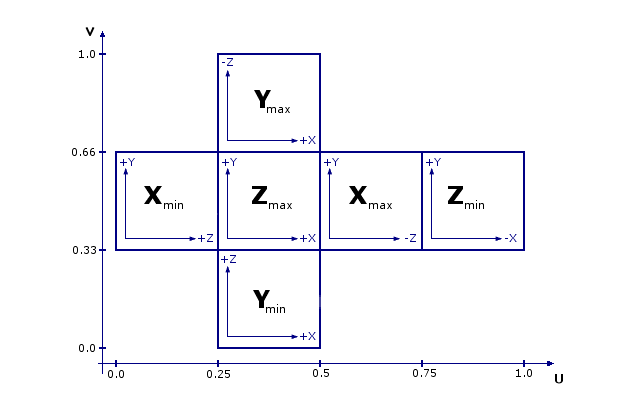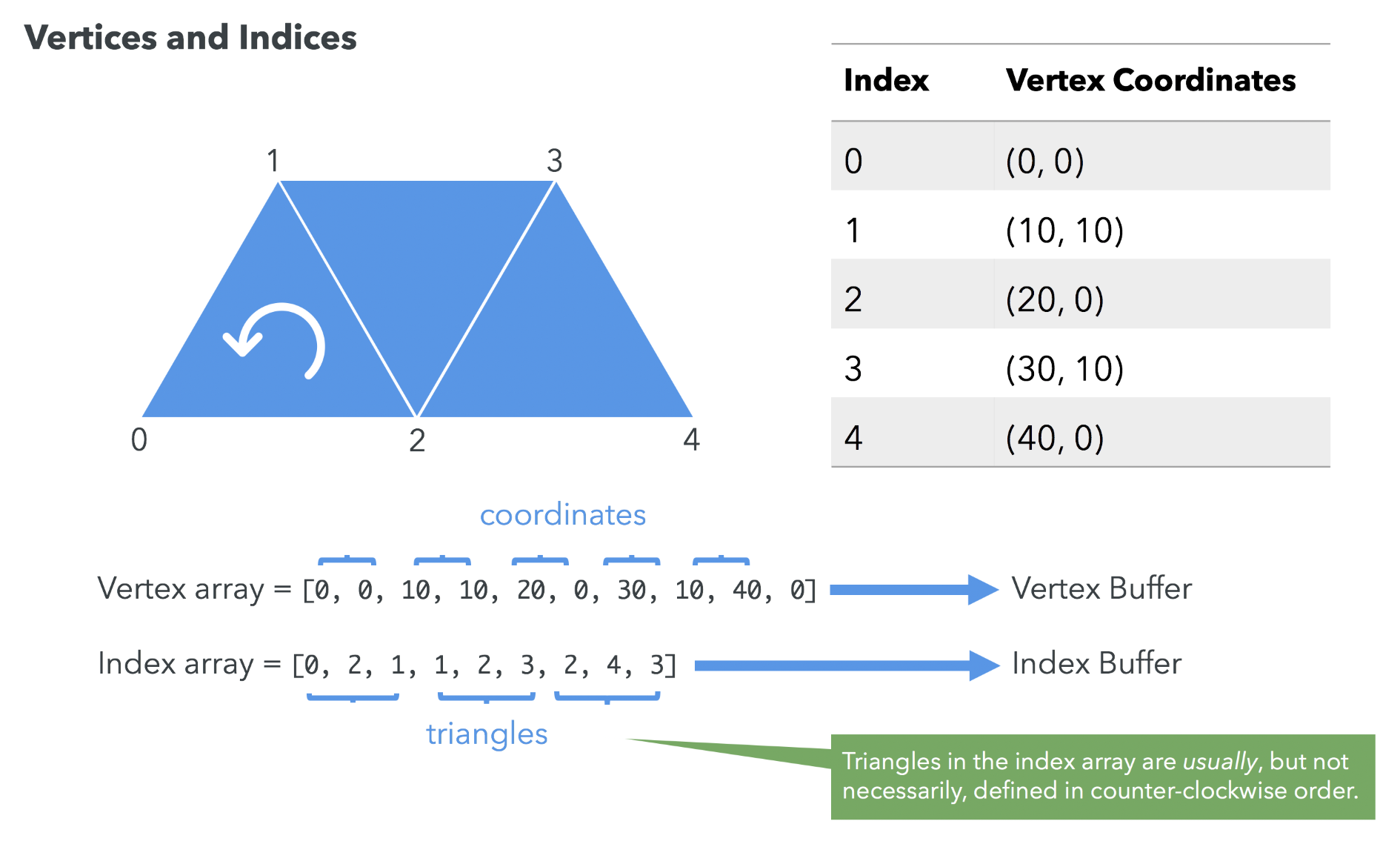3D Graphics Engine Fundamentals: Triangles, UV Mapping, Vertices & Indices Explained
Introduction
Recently, while developing AR features on iOS and Android, I discovered my complete unfamiliarity with 3D graphics. After spending time deeply understanding the concepts, I finally pieced together some fundamental ideas. This article organizes several core concepts to share with others who are also exploring 3D graphics.
Understanding 3D graphics fundamentals is essential for:
- Game Development: Creating immersive 3D worlds
- AR/VR Applications: Building augmented and virtual reality experiences
- Computer Graphics: Understanding rendering pipelines
- Mobile Development: Implementing 3D features on mobile platforms
All Objects in 3D Worlds Are Composed of “Triangles”

In 3D modeling, almost all objects are composed of countless “small triangles” called Mesh. Higher resolution means denser mesh triangles.
Why Triangles?
Triangles are the fundamental building blocks of 3D graphics because:
- Planar Surface: Three points always define a flat surface
- GPU Optimization: Graphics hardware is optimized for triangle rendering
- Flexibility: Any complex shape can be approximated with triangles
- Efficiency: Triangles are the simplest polygon to process
Triangle Resolution Impact
| Resolution | Triangle Count | Quality | Performance |
|---|---|---|---|
| Low | 100-1,000 | Basic shape | Fast rendering |
| Medium | 1,000-10,000 | Good detail | Balanced |
| High | 10,000+ | High detail | Slower rendering |
What is UV Mapping?
The process of projecting 2D images onto 3D model surfaces to give models textures
This process is like applying skin to a 3D object, called UV mapping.

For example, a cube’s six faces can be unfolded into a 2D plane (like paper cutting), then the corresponding texture is applied, allowing correct image representation in 3D space.
UV Coordinate System
UV coordinates are represented as (U, V):
- U: Horizontal axis (0 to 1)
- V: Vertical axis (0 to 1)
- Origin: Top-left corner (0,0)
- End Point: Bottom-right corner (1,1)

UV Mapping Techniques
1. Planar Mapping
- Projects texture from one direction
- Best for flat surfaces
- Simple but may cause distortion
2. Cylindrical Mapping
- Wraps texture around cylindrical objects
- Good for bottles, pipes, characters
- Maintains aspect ratio
3. Spherical Mapping
- Maps texture onto spherical surfaces
- Ideal for planets, balls, heads
- May cause distortion at poles
Vertices & Indices (Vertex and Index Management)
In computer graphics, we don’t draw triangles directly. Instead, we record “which vertices form which triangles,” requiring:
- Vertices: Record each spatial position
- Indices: Define triangle connection relationships

For example, triangle order [0, 2, 1] means connecting from vertex 0 to vertex 2, then to vertex 1.
Vertex Data Structure
struct Vertex {
float x, y, z; // Position
float u, v; // UV coordinates
float nx, ny, nz; // Normal vector
float r, g, b, a; // Color
};
Index Buffer Example
// Define vertices
Vertex vertices[] = {
{0.0f, 0.0f, 0.0f, 0.0f, 0.0f}, // Vertex 0
{1.0f, 0.0f, 0.0f, 1.0f, 0.0f}, // Vertex 1
{0.5f, 1.0f, 0.0f, 0.5f, 1.0f} // Vertex 2
};
// Define triangles using indices
unsigned int indices[] = {
0, 2, 1 // Triangle 1
};
Memory Optimization
Using indices provides significant memory savings:
- Without Indices: Each triangle stores 3 complete vertices
- With Indices: Vertices shared between triangles
- Savings: Up to 70% memory reduction for complex models
Face Orientation: Using the “Right-Hand Rule”
We typically use counterclockwise direction to define the “front” of a face.
If you want to display both front and back faces, define two sets of indices:
Front face: [0, 2, 1]
Back face: [0, 1, 2]
Right-Hand Rule Application
- Point your thumb in the direction you want the face to face
- Curl your fingers in the vertex order
- Face normal points in thumb direction
💡 Using this method to create double-sided triangles is a common technique in AR and 3D games.
Culling Optimization
// Enable back-face culling
glEnable(GL_CULL_FACE);
glCullFace(GL_BACK);
// For double-sided rendering
glDisable(GL_CULL_FACE);
Real-World Applications
Game Development
- Character Models: Detailed 3D characters with textures
- Environment Design: Buildings, landscapes, props
- UI Elements: 3D menus and HUD elements
- Particle Systems: Complex visual effects
AR/VR Applications
- Object Recognition: 3D model matching
- Spatial Mapping: Environment reconstruction
- Virtual Objects: Interactive 3D elements
- Hand Tracking: Gesture recognition
Mobile Development
- ARKit (iOS): Apple’s AR framework
- ARCore (Android): Google’s AR platform
- SceneKit: iOS 3D graphics framework
- Sceneform: Android 3D rendering library
Performance Considerations
Triangle Count Optimization
| Platform | Recommended Triangle Count |
|---|---|
| Mobile (Low-end) | 1,000 - 5,000 |
| Mobile (High-end) | 5,000 - 20,000 |
| Desktop | 10,000 - 100,000 |
| VR | 50,000 - 200,000 |
Rendering Pipeline Optimization
- Level of Detail (LOD): Use different detail levels based on distance
- Frustum Culling: Only render visible objects
- Occlusion Culling: Skip hidden objects
- Texture Streaming: Load textures on demand
Memory Management
// Efficient vertex buffer usage
glGenBuffers(1, &VBO);
glBindBuffer(GL_ARRAY_BUFFER, VBO);
glBufferData(GL_ARRAY_BUFFER, sizeof(vertices), vertices, GL_STATIC_DRAW);
// Index buffer for efficiency
glGenBuffers(1, &EBO);
glBindBuffer(GL_ELEMENT_ARRAY_BUFFER, EBO);
glBufferData(GL_ELEMENT_ARRAY_BUFFER, sizeof(indices), indices, GL_STATIC_DRAW);
Best Practices for 3D Graphics
Modeling Guidelines
- Keep it Simple: Start with low-poly models
- Optimize Topology: Use efficient vertex placement
- Plan UV Layout: Design texture space efficiently
- Test Performance: Profile on target devices
Texture Optimization
- Power of 2: Use 512x512, 1024x1024, etc.
- Compression: Use appropriate texture formats
- Mipmaps: Generate for better performance
- Atlas Textures: Combine multiple textures
Code Organization
class Mesh {
private:
std::vector<Vertex> vertices;
std::vector<unsigned int> indices;
unsigned int VAO, VBO, EBO;
public:
void setupMesh();
void draw();
void cleanup();
};
Common Pitfalls and Solutions
UV Mapping Issues
Problem: Texture stretching or distortion Solution:
- Use proper UV unwrapping techniques
- Avoid overlapping UV coordinates
- Maintain consistent texture density
Performance Problems
Problem: Slow rendering with complex models Solution:
- Reduce triangle count
- Implement LOD system
- Use efficient rendering techniques
- Profile and optimize bottlenecks
Memory Issues
Problem: High memory usage Solution:
- Use index buffers
- Implement texture streaming
- Optimize vertex data
- Use compression techniques
Tools and Resources
3D Modeling Software
- Blender: Free, powerful 3D suite
- Maya: Professional 3D software
- 3ds Max: Industry standard
- SketchUp: Easy to learn
Game Engines
- Unity: Cross-platform game engine
- Unreal Engine: High-end graphics
- Godot: Open-source alternative
- Cocos2d-x: Mobile-focused
Learning Resources
Related Articles
- Getting Started with AR Development on iOS
- WebRTC and Real-time Communication
- Advanced Image Optimization Techniques
Summary
Whether you’re working with iOS, Android, or Web, these fundamental concepts are essential for any 3D technology, game development, AR, or VR applications. I hope this article helps you understand the basic logic of 3D graphics programming! 🚀
Key Takeaways
- Triangles are fundamental: All 3D objects are built from triangles
- UV mapping is crucial: Enables texture application to 3D surfaces
- Vertices and indices matter: Efficient memory usage and rendering
- Performance optimization: Balance quality with performance
- Practice makes perfect: Start simple and gradually increase complexity
TIP
If you have different perspectives, technical experiences, or want to discuss advanced 3D architecture design, feel free to leave a comment or email me. Let’s learn and grow together! ��
Enjoy Reading This Article?
Here are some more articles you might like to read next: